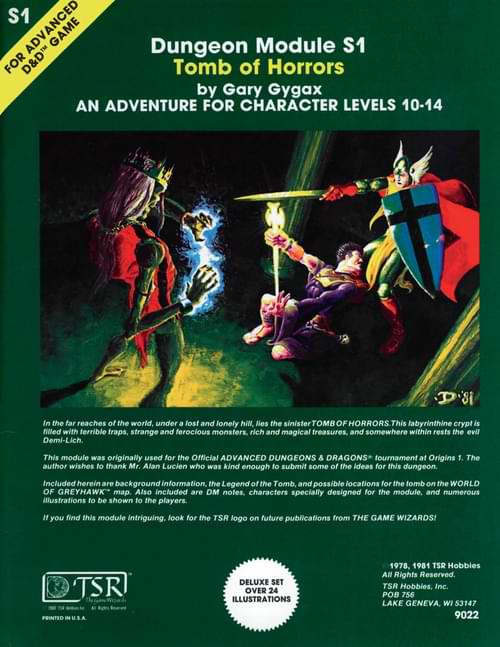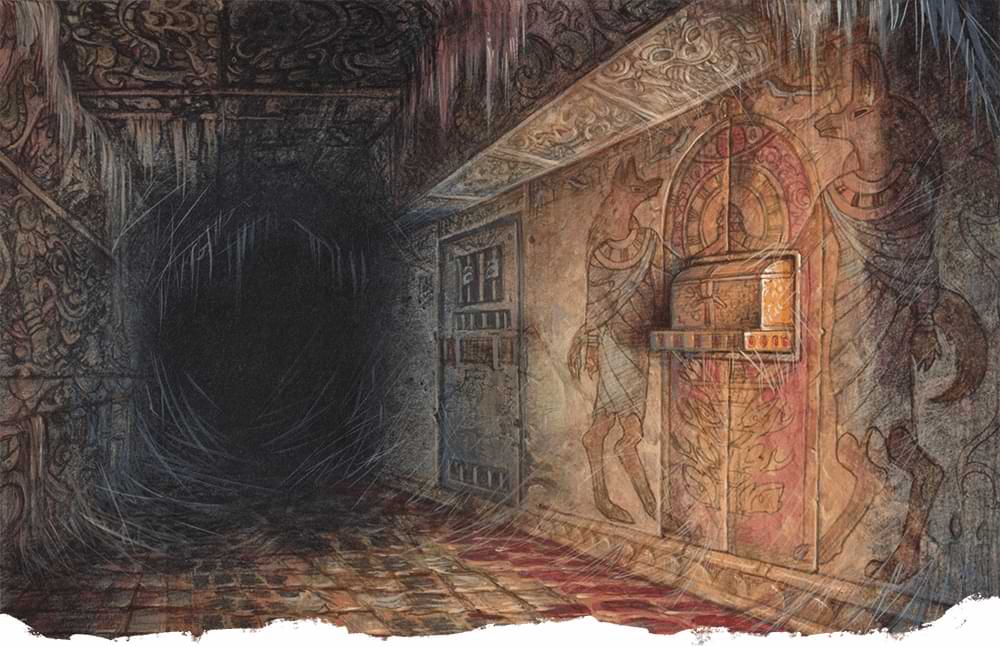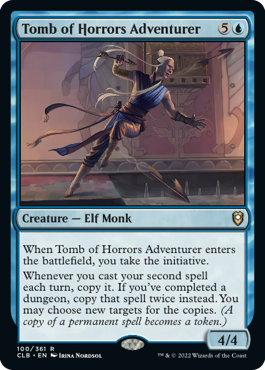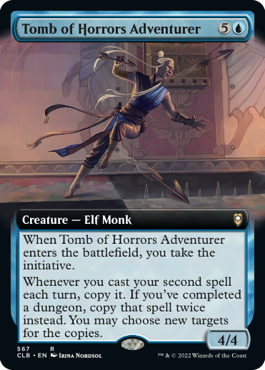Are you sure you want to do that? No truer words have been uttered than in the Tomb of Horrors. A labyrinthine crypt known to annihilate even the most powerful of characters, the Tomb of Horrors is home to the infamous demilich Acererak and has appeared in nearly every edition of Dungeons & Dragons.
To celebrate this dungeon, we're digging into the history and lore behind it, and previewing a Magic: The Gathering card that pays homage to it. The trading card will appear in the upcoming Commander Legends: Battle for Baldur's Gate set, which releases on June 10, 2022.
- What is the Tomb of Horrors?
- The lich lying in wait
- Lessons from the Tomb of Horrors
- Card preview: Tomb of Horrors Adventurer
What Is Commander Legends: Battle for Baldur's Gate?
Magic: The Gathering (MTG) is a trading card game by Wizards of the Coast. The upcoming set Commander Legends: Battle for Baldur's Gate takes players into the Forgotten Realms and beyond. But this isn't the first time the two games have had a crossover. The 2021 MTG set Adventures in the Forgotten Realms was the game's first big dive into D&D. Meanwhile, the D&D books Guildmasters' Guide to Ravnica, Mythic Odysseys of Theros, and Strixhaven: A Curriculum of Chaos have taken fifth-edition D&D players into popular MTG settings.
What Is the Tomb of Horrors?
 Buried beneath a lonely hill lies the deadliest dungeon a D&D character can undertake, the Tomb of Horrors. Unforgiving traps, puzzles, and monsters lie in wait here, protecting untold treasures belonging to the cruel demilich Acererak. For most players, the treasures that lie at the end of this dungeon are an unrealized dream. But it isn't the loot that draws players to this adventure, it's the challenge.
Buried beneath a lonely hill lies the deadliest dungeon a D&D character can undertake, the Tomb of Horrors. Unforgiving traps, puzzles, and monsters lie in wait here, protecting untold treasures belonging to the cruel demilich Acererak. For most players, the treasures that lie at the end of this dungeon are an unrealized dream. But it isn't the loot that draws players to this adventure, it's the challenge.
Tomb of Horrors was written by D&D co-creator Gary Gygax to test players' meddle. It was introduced to the wider D&D community in 1975 for a tournament held at the first Origins game convention. During this tournament, players competed to see how far they could progress through the Tomb of Horrors.
In order to create an equitable play experience, Gygax included precise descriptions and imagery for DMs to use. This not only allowed players from different tables to share similar experiences in the adventure, but it also allowed DMs to be ruthless as their players failed to survive the many challenges found in the Tomb of Horrors—often in spectacular fashion.
Tomb of Horrors quickly rose to legendary status. It was first published in 1978 and has been republished throughout D&D's history, most recently in the adventure module anthology Tales from the Yawning Portal.
The Lich Lying in Wait
Every good dungeon needs a big bad at the center of it, and the Tomb of Horrors is no exception. Characters that survive a romp through the passages and rooms of the Tomb of Horrors can look forward to its deadliest encounter yet, a visit from the nigh-unkillable Acererak.
Like many great villains, Acererak has humble beginnings. He was a human wizard/cleric who sought immortality, and so started down the path to lichdom. Becoming a lich is no easy feat. Many mages conspire with evil gods, fiends, or other horrors to learn how to become a lich. I won't share such secrets, but I can tell you this much: A lich finally achieves immortality when they trap their soul within a phylactery. Doing so binds their soul to their mortal realm, preventing death. Maintaining a phylactery requires a lich to feed souls to it. (The eldritch lich is an exception to this rule.) Fail to do so, and the lich's undeath will begin to waiver, as was the case for Acererak.
Acererak is a demilich, which is a lich that has failed to feed enough souls to maintain its phylactery and whose body has turned to dust, leaving behind a haunted skull. But don't be fooled, this mere skull is enough to best even the mightiest of adventurers.
Lessons From the Tomb of Horrors

It's commonly said that you can only truly experience the Tomb of Horrors module once. It's intended to be run exactly as written, but that doesn't mean DMs can't borrow ideas or glean wisdom from it for future meatgrinder adventures. Without spoiling the traps that lie in Tomb of Horrors, here are tips DMs can use to make their sessions more challenging for players:
- Set Expectations From the Start: It's no secret Tomb of Horrors is a deadly dungeon delve. Players have been losing characters to it for decades. But if you're a DM who plans to run a meatgrinder adventure, it's important to communicate that with your players before the start of your first session. That way, no one is surprised when the bloodshed begins.
- Allow Your Players to Fail: Part of the joy of D&D is leaning into the failures that come during play. When it comes to meatgrinder adventures, it's important for DMs to set real stakes and to allow characters to suffer the consequences of their missteps.
- Use Precise Language: A solid Wisdom (Perception) or Intelligence (Investigation) check won't necessarily reveal every secret behind a trap or unveil the answers to a puzzle. Provide literal descriptions to what the characters are seeing and let the players ponder over your answers. If they have follow-up questions, they can ask them and you can request additional rolls, if it's appropriate.
- Practice Your Poker Face: When the characters are prying open a treasure chest or hop-skipping down a corridor, there's no greater giveaway that a trap lies ahead than your own evil grin. Having a good poker face can keep you from inexplicitly giving away additional information to your players.
Card Preview: Tomb of Horrors Adventurer
The Tomb of Horrors is no dungeon for low-level adventurers. So, it's no surprise that our preview card for Commander Legends: Battle for Baldur's Gate is a six mana creature with solid power and toughness and abilities.


When the Tomb of Horrors Adventurer enters the battlefield, you take the initiative. This means you either enter or progress in the Undercity, a special dungeon tied to the initiative mechanic. As long as you have the initiative, you'll venture deeper into the Undercity at the beginning of your upkeep. Take combat damage from another player, though, and they'll take the initiative.
The card also rewards you for casting your second spell each turn. Do so and that spell will be copied. If you've completed a dungeon—it doesn't have to be the Undercity—you'll get two copies of that spell instead. Not bad, if you can get the Tomb of Horrors Adventurer to stick.
Let's Go on an Adventure!
With vast worlds to explore, countless NPCs with storied histories, and all manner of ways to enjoy the trials that come with adventuring, D&D offers countless hours of fun with your friends. D&D Beyond is the official toolset for the game and offers everything you need to start playing today, including the basic rules, the Lost Mine of Phandelver starter adventure, and tools that allow you to make your first character in minutes or prepare a session for your players. All you need to do to get started is sign up for a D&D Beyond account, which comes at no cost!
Michael Galvis (@michaelgalvis) is a tabletop content producer for D&D Beyond. He is a longtime Dungeon Master who enjoys horror films and all things fantasy and sci-fi. When he isn’t in the DM’s seat or rolling dice as his anxious halfling sorcerer, he’s playing League of Legends and Magic: The Gathering with his husband. They live together in Los Angeles with their adorable dog, Quentin.

-
View User Profile
-
Send Message
Posted May 23, 2022Pretty neat article! Too bad its pushed so far down :P
-
View User Profile
-
Send Message
Posted May 23, 2022Great article, though I personally don't like the dungeon. In my opinion, it is made more for the entertainment of the DM than the players.
-
View User Profile
-
Send Message
Posted May 23, 2022Just wanted to mention this: when you’re talking about achieving Lichdom you say “Evil God, or Friends” not “Fiends”
-
View User Profile
-
Send Message
Posted May 23, 2022cmon whenever I wanna become a undead immortal evil dude I chat up my friends
-
View User Profile
-
Send Message
Posted May 24, 2022Thanks for pointing this out, it's been fixed! Although, isn't the true gift of immortality the friends we made along the way?
-
View User Profile
-
Send Message
Posted May 24, 2022Gygax made it specifically to "deal" with players who said they were amazingly powerful and could handle anything. It is literally the- Player: "I can survive anything". Gygax and Dm's to follow: "Hold my beer."
-
View User Profile
-
Send Message
Posted May 24, 2022The one Dungeon I flatly refuse to play again.
-
View User Profile
-
Send Message
Posted May 24, 2022same here homie
-
View User Profile
-
Send Message
Posted May 26, 2022That’s sort of what it’s all about
-
View User Profile
-
Send Message
Posted May 26, 2022It’s worth mentioning that Acererak willingly became a demilich. His end goal was to allow his soul to wander the multiverse. His demilich body was placed in the tomb to draw in adventurers. Their souls provide enough to keep him at demilich status. I love the Tomb of Horrors. I am currently running Tomb of Annihilation. It might be my favorite.
edit: that hasn’t been retconned either. The Acererak in TOA isn’t the original. Won’t spoil anything there.
-
View User Profile
-
Send Message
Posted May 26, 2022If I've got Anhelo copying my first instant or sorcery, and ToHA here copying my second, that sounds alright to me.
Though, the flavor win would have been making the Tomb of Horrors Adventurer a corpse. Or a little pile of ash. Or a torn-up character sheet.
-
View User Profile
-
Send Message
Posted May 26, 2022Great article! I have to ask, you say Acererak was a human, but wasn't he a half-fiend of some sort?
-
View User Profile
-
Send Message
Posted May 27, 2022He was a Cambion. Not sure where anyone got human from.
-
View User Profile
-
Send Message
Posted May 28, 2022Great advice for GM's on how to relate info to players (before and during the game) and how to GM in difficult situations (ie the player is not the PC and the PC is not the player).
-
View User Profile
-
Send Message
Posted May 31, 2022Test the players' "meddle"?
-
View User Profile
-
Send Message
Posted Jun 1, 2022absolutely amazing. i cant figure out the mtg 'you take the initiative' stuff tho.
-
View User Profile
-
Send Message
Posted Jun 13, 2022When did this mechanic of the lich needing to feed on souls appear? It wasn't there in 2nd Edition (I know I sound like a toothless gramps when I make statements like this.) Btw, here is how to become a lich:
In order to become a lich, the wizard must prepare its phylactery by use of the enchant an item, magic jar, permanency and reincarnation spells. The phylactery, which can be almost any manner of object, must be of the finest craftsmanship and materials with a value of not less than 1,500 gold pieces per level of the wizard. Once this object is created, the would-be lich must craft a potion of extreme toxicity, which is then enchanted with the following spells: wraithform, permanency, cone of cold, feign death, and animate dead. When next the moon is full, the potion is imbibed. Rather than death, the potion causes the wizard to undergo a transformation into its new state. A system shock survival throw is required, with failure indicating an error in the creation of the potion which kills the wizard and renders him forever dead. In life the wizard must have achieved at least 18 level.
-
View User Profile
-
Send Message
Posted Nov 14, 2022makes scense